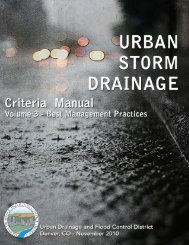Hydraulic Efficiency of Grate and Curb Inlets - Urban Drainage and ...
Hydraulic Efficiency of Grate and Curb Inlets - Urban Drainage and ...
Hydraulic Efficiency of Grate and Curb Inlets - Urban Drainage and ...
You also want an ePaper? Increase the reach of your titles
YUMPU automatically turns print PDFs into web optimized ePapers that Google loves.
design characteristics, higher efficiency would result than either is capable <strong>of</strong> independently.<br />
The local depression would act to reduce splash-over <strong>and</strong> capture more side flow, while the<br />
directional vanes would capture frontal flow. A full testing program similar to this study would<br />
be required to develop design equations, or extend the UDFCD methods, for such an inlet.<br />
Engineering application <strong>of</strong> the Type 13 grate inlet typically involves placing a single grate in a<br />
sump condition with no curb component (such as in a parking lot or field). Placing a single Type<br />
13 grate in such a configuration typically exposes it to direct flow from all sides. In the testing<br />
program performed for this study, the inlet was placed adjacent to a curb <strong>and</strong> exposed to lateral<br />
flow from three sides. Only at the 1-ft flow depth was it exposed to flow from over the curb.<br />
Testing the Type 13 grate in a true sump condition, where it is exposed to flow from all sides,<br />
would provide additional useful data. A slightly different model than the one used in this study<br />
would be necessary to collect data on this configuration.<br />
For the analysis presented in this report, the observed test data were used in UDFCD<br />
methods developed from the original FHWA model data. The purpose was to adapt the UDFCD<br />
methods to include the inlets tested in this study. The converse <strong>of</strong> that analysis would be to use<br />
the FHWA model data in the empirical equations developed in this report. A comparison could<br />
then be made between the two methods <strong>and</strong> their ability to be adapted to suit other inlet types.<br />
The additional testing suggested in this section would complete the body <strong>of</strong> knowledge<br />
available for common application <strong>of</strong> the Type 13, 16, <strong>and</strong> R inlets. The UDFCD methods could<br />
be easily extended to encompass the additional data, <strong>and</strong> independent design equations similar to<br />
those presented in this study could be developed for the additional configurations.<br />
81
















